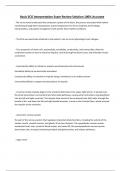Basic ECG interpretation Exam Review Solution 100% Accurate - The nurse should understand the conduction system of the heart, the process associated with rhythm monitoring through ECG interpretation, patient preparation for the 12 -lead ECG, ECG findings , interpretation, and patient management with specific heart rhythm conditions. - The ECG uses electrodes attached to the patient's skin to record physiologic heart changes. - Four properties of heart cells, automaticity, excitability, conductivity, an d contractility, allow the conduction system to start an electrical impulse, send it through the heart tissue, and stimulate muscle contraction. - Automaticity Ability to initiate an impulse spontaneously and continuously Excitability Ability to be electrically stimulated Conductivity Ability to transmit an impulse along a membrane in an orderly manner Contractility Ability to respond mechanically to an impulse - A normal cardiac impulse begins in the sinoatrial (SA) node in the upper right atrium. It spreads over the atrial myocardium via interatrial and internodal pathways, causing atrial contraction, pumping blood into the left and right ventricles. The impulse then travels to the atrioventricular (AV) node, through the bundle of His, and down the left and right bundle branches. It ends in the Purkinje fibers, which transmit the impulse to the ventricles. - autonomic nervous system the part of the nervous system that regulates involuntary body functions, including the activity of the cardiac muscle, smooth muscles, and glands. It has two divisions: The sympathetic nervous system accelerates heart rate, constricts blood vessels, and raises BP; the parasympathetic nervous system slows heart rate, increases intestinal peri stalsis and gland activity, and relaxes sphincters. - vagus nerve either of the longest pair of cranial nerves mainly responsible for parasympathetic control over the heart and many other internal organs, including thoracic and abdominal viscera. - parasympathetic nervous system pertaining to the craniosacral division of the autonomic nervous system, consisting of the oculomotor, facial, glossopharyngeal, vagus, and pelvic nerves. The actions of the parasympathetic division are mediated by the release o f acetylcholine and primarily involve the protection, conservation, and restoration of body resources. Reactions to parasympathetic stimulation are highly localized and tend to counteract the adrenergic effects of sympathetic nerves. Parasympathetic fibers slow the heart; stimulate peristalsis; promote the secretion of lacrimal, salivary, and digestive glands; induce bile and insulin release; dilate peripheral and visceral blood vessels; constrict the pupils, esophagus, and bronchioles; and relax sphincters during micturition and defecation. Postganglionic parasympathetic fibers extend to the uterus, vagina, oviducts, and ovaries in females and to the prostate, seminal vesicles, and external genitalia in males, innervating blood vessels of pelvic organs in b oth sexes; stimulation of these nerves causes vasodilation in the clitoris and labia minora and erection of the penis. - sympathetic nervous system pertaining to a division of the autonomic nervous system. - The components of the autonomic nervous syst em that affect the heart are the vagus nerve fibers of the parasympathetic nervous system and nerve fibers of the sympathetic nervous system - Stimulation of the vagus nerve causes a decreased rate of firing of the SA node and slowed impulse conduction o f the AV node. Stimulation of the sympathetic nerves increases SA node firing, AV node impulse conduction, and cardiac contractility (Patton, 2013). - depolarization the reduction of a membrane potential to a less negative value. - repolarization the process by which the membrane potential of a neuron or muscle cell is restored to the cell's resting potential. In a cardiac muscle cell, the repolarization process begins after phase 0 of the action potential and is completed by the end of phase 3. It en compasses the effective and relative refractory periods and correlates with the Q -T interval on the ECG. - The membrane of a heart cell is semipermeable. This allows it to maintain a high concentration of potassium and a low concentration of sodium inside the cell. Outside the cell a high concentration of sodium and a low concentration of potassium exist. Th e inside of the cell, when at rest, or in the polarized state, is negative compared with the outside. When a cell or groups of cells are stimulated, the cell membrane changes its permeability. This allows sodium to move rapidly into the cell, making the inside of the cell positive compared with the outside (depolarization). A slower movement of ions across the membrane restores the cell to the polarized state, called repolarization. - The depolarization and repolarization of the myocardial cells allows fo r the electrical impulses to be measured using an electrocardiogram to evaluate heart function. - Remember to always monitor potassium levels in your patients —even small variances above or below normal levels can cause problems with cardiac muscle conduc tion, causing dysrhythmias. Match the property of the cardiac conduction system with its description. Property of the cell that allows it to accept initiation of stimulation Property that moves electrical impulse along a membrane Ability of heart muscle t o respond mechanically to an impulse Ability of heart muscle to initiate an impulse, begin stimulation Automaticity Excitability Conductivity Contractility - Property of the cell that allows it to accept initiation of stimulation Excitability Property th at moves electrical impulse along a membrane Conductivity




